January, 2015 —
OK, so we thought we would sign off on the blog until our spring sailing resumed, but we have found there is just too much of interest to not share it. The Christmas season in Spain has many different traditions than in the US. We have enjoyed participating in as many of them as we can.
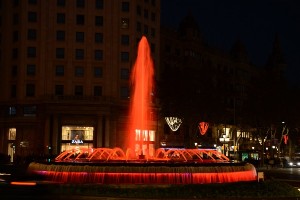
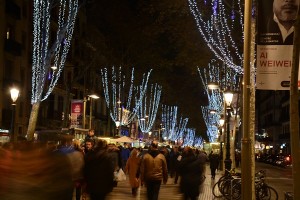 Spain is a predominantly Catholic country so most of the traditions are based on the Advent calendar. December 8th, the Feast of the Immaculate Conception, is the real start of the Christmas season here. It is then that families decorate their homes, and the Christmas decorations around the city reach their peak. Lights are strung across the main streets and the alleyways throughout the city. Each street has its own pattern of lights, all of which are very colorful. The variety from street to street adds to the feeling of celebration.
Spain is a predominantly Catholic country so most of the traditions are based on the Advent calendar. December 8th, the Feast of the Immaculate Conception, is the real start of the Christmas season here. It is then that families decorate their homes, and the Christmas decorations around the city reach their peak. Lights are strung across the main streets and the alleyways throughout the city. Each street has its own pattern of lights, all of which are very colorful. The variety from street to street adds to the feeling of celebration.
The nativity scene is an important tradition of Spanish culture. One of the largest nativity scenes, if not the largest, is set up every year right here in the gothic quarter near the marina. It features one-third life size figures and many creative elements to simulate water, landscape and the like. Also, most homes display at least one nativity scene ranging anywhere from the simple to the fancy. 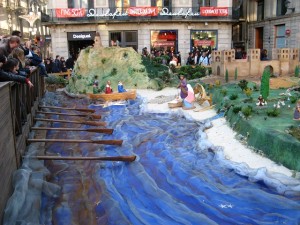 There is a large outdoor market that sells the entire nativity scenes, individual figures and all sorts of stuff of every size to suit any scene.
There is a large outdoor market that sells the entire nativity scenes, individual figures and all sorts of stuff of every size to suit any scene.
One unusual figure in most nativities is the “Cagoner” or “little shitter”. It is a figure of a Catalan man, generally wearing traditional Catalan clothes. He is squatting with his pants around is ankles and is pooping. It is a custom from the 18th century. His poop is seen as a sign of good luck as it fertilizes the earth and ensures a good harvest for the coming year. Some figures are more graphic than others. Although this is a serious tradition, some crafts people have really run with it and you can find Cagoner figures in the likes of: the Pope, the King, Prince Charles, President Obama, and so on, not to mention hundreds of other notables.
Another tradition is the “Caga Tio” which also comes out on December 8th. It is a small log with a smiley face, wearing a traditional red Catalan hat. Children cover it with a blanket and keep it warm until Christmas Eve. That night, after a large family dinner, children are given a stick and take turns hitting the log while singing a traditional song about the log. The log then pops out candy and small gifts for the children. It is their version of Christmas stockings. Children in Spain do not receive their large gifts until January 6th, the Feast of the Epiphany, which is the 12th day of Christmas.
For the children, after that very long wait, January 6th finally arrives. This is the day the three Wise Men arrived in Bethlehem to present gifts and herbs to the newborn. 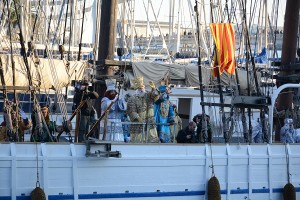 In Barcelona the three Wise Men arrive on the 5th by boat which happens to be here in the harbor right near our boat. There they are met by the Mayor who gives them a key.
In Barcelona the three Wise Men arrive on the 5th by boat which happens to be here in the harbor right near our boat. There they are met by the Mayor who gives them a key.
That key is supposed to open all of the doors in the city for them to leave gifts for the kids. Clever, as the city dwellers don’t have fireplaces with chimneys! What have the kids been doing to prepare for this day? – well making their lists as all kids do. The Three Wise Men board three separate floats within a larger group and parade through the city streets. Children present their wish lists to the Wise Men either as they arrive or through the Wise Men’s helpers (also in costume) on the floats.
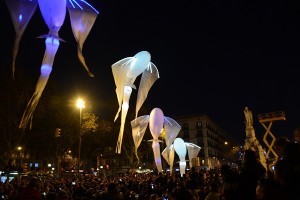 We would compare the parade to Carnival. There were more than a dozen large floats along with dancers and performers, helium filled balloons in the shape of dolphins, the Three Kings each with their attendants, and floats shooting candy to the crowd out of fire hose type apparatus. The creativity of the floats was amazing. The parade travels a 5 km route through the central city. It took over an hour for it to completely pass by us. The crowd, packed with kids, was 15 people deep. Even as adults we found it enchanting.
We would compare the parade to Carnival. There were more than a dozen large floats along with dancers and performers, helium filled balloons in the shape of dolphins, the Three Kings each with their attendants, and floats shooting candy to the crowd out of fire hose type apparatus. The creativity of the floats was amazing. The parade travels a 5 km route through the central city. It took over an hour for it to completely pass by us. The crowd, packed with kids, was 15 people deep. Even as adults we found it enchanting.
That night the children put their shoes out, along with food for the Three Kings and a bucket of water for the camels. In the morning, the shoes are covered with gifts left by the Three Kings. January 6th, the Feast of the Epiphany, is a national holiday in Spain just as December 25th is in the U.S.
That frees up one route on Christmas Eve, giving Santa more time to cover the rest of the world!

Sounds like fun. Enjoy!